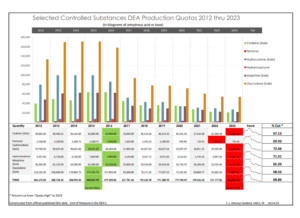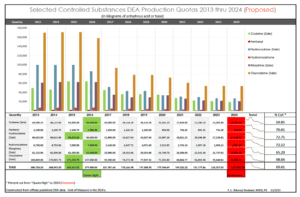A two headed monster is attacking the supply of FDA approved pain medications. One of the heads is Medusa-like, consisting of 41 state Attorneys General. The other head is our old nemesis, the DEA.
Several months ago, thanks to my associate Patricia A Irving RN, I became interested in the significant negative impact of last year’s 41 state AGs’ “Nation-wide Settlement” with the three major distributors (wholesalers) of controlled substances, McKesson, AmerisourceBergen, and Cardinal Health. I soon agreed with her concerns after carefully reading all 54 pages of this settlement’s Injunctive Relief which is labeled, “Exhibit P”. A fair assessment of the impact of this settlement’s “injunctive relief” requires all 54 pages to be read. Exhibit P begins on page 478 of the 571 page settlement: Final-Distributor-Settlement-Agreement-3.25.22-Final.pdf.
Pat and I contend this settlement’s injunctive relief, with its mandated “Thresholds” (which the distributors MUST establish and KEEP SECRET from the pharmacies they supply), “Red Flags”, “Onboarding”, “Terminated Customers”, ad infinitum, are resulting in insufficient supply to pharmacies of existing, already manufactured controlled substances, not just opioids. The injunctive relief is very onerous and intimidating, I believe by design. The entire supply chain is rightfully afraid and therefore being overly cautious/restrictive. The latest government inflicted harm Chronic Pain Patients (CPPs) are now experiencing was the easily foreseeable outcome of this injunctive relief. Pat Irving had her excellent article on this subject recently published in Pain News Network. The National Opioid Settlement Is Causing Drug Shortages — Pain News Network
It was my interest in her concern about the settlement’s additional negative impact on the supply chain which prompted my researching the severity of the DEA’s opioid production quota cuts and therefore their negative impact on the supply chain. Just looking at the numbers did not convey to me the across-the-board magnitude of these progressive cuts. I decided to use an Excel based graph to “show” the 2012 through 2023 DEA manufacturing/production quotas for some common pain medications. You can see the shocking result in the graphic below.

A lesser-known supply shortage issue I recently discovered is the DEA, just this past August 31st, reduced the “inventory allowance” manufacturers were allowed to retain on hand to cover unforeseen supply chain/manufacturing issues was reduced from 50% to 40%, further constricting the efficient supply of opioid medications. Brace Yourself: DEA’s Final Rule on Quotas Squeezes Inventory Levels and Signals Further Supply Restrictions | Quarles & Brady LLP – JDSupra
I have witnessed on social media the alarming uptick in the number of pain patients finding their pharmacies unable to fill their legitimate prescriptions because the pharmacies are out of stock. This prompted me to research the ASPH.org Current Drug Shortages – ASHP and the Drugs.com Current Drug Shortages List – Drugs.com shortage databases, both of which list significant shortages of Hydrocodone and both variants of Oxycodone. (I learned from Pat Anson of PNN News Network, these two databases are essentially one in the same.) I also viewed the FDA drug shortages database FDA Drug Shortages. To my surprise, the FDA lists ZERO hydrocodone and oxycodone shortages. This dichotomy is a major problem. If the FDA does not even acknowledge there is a shortage of these two medicines, the FDA will certainly take no related remedial action, like they recently did in concert with the DEA, to address ADHD medications shortages. Adderall makers agree to increase production: DEA (msn.com).
To make matters worse, at a time when production quotas should obviously be increased, the just announced proposed DEA 2024 opioid production quotas cuts do the opposite! Adding insult to injury, the FDA came to this inexplicable conclusion: “FDA predicts that levels of medical need for schedule II opioids in the United States in calendar year 2024 will decline on average 7.9 percent from calendar year 2023 levels.” Regulations.gov. While the non-sensical proposed cuts from 2023 appear relatively minor in the macro view, they still cut production quotas of the six medications I graphed as follows: Codeine -8.3%, Fentanyl -7.6%, Hydrocodone -0.3%, Hydromorphone -2.1%, Morphine -4,3%, Oxycodone -0.3%. See my revised graphic for 2013 through 2024 (Proposed).

We have until Dec 4th to submit professional (avoiding emotions and expletives) comments on the DEA proposed 2024 production quotas. Cite the shortages you are already experiencing on pharmacy shelves to support your request that the DEA increase their opioid production quotas, NOT cut them further! Comments can be submitted via this link: Regulations.gov.
















Great job on the article, Monty! This reduction flies in the face of logic as us baby boomers age.
Thank you, Louis! These latest proposed reductions definitely do fly in the face of logic!
Monty,
Thank you and Pat for your comprehensive and insightful analysis. Your article shines a much-needed light on the complexities and unintended consequences of the opioid settlements and the DEA’s actions, particularly how they affect chronic pain patients.
As a chronic pain patient and an activist, I can attest to the real-world impact of these policies. The “injunctive relief” and production quota cuts you describe are not just numbers on a page but represent significant barriers to accessing necessary medications for individuals like me. This has created a dire situation where managing chronic pain becomes a daily struggle, often compounded by the anxiety of uncertain medication availability.
Your findings about the discrepancy between the FDA’s reporting and actual drug shortages are alarming and reflect a disconnect that urgently needs addressing. The lack of recognition of these shortages by the FDA is a critical oversight, as it hinders the possibility of remedial actions that could alleviate the suffering of thousands, if not more.
Your call to action for professional commentary on the DEA’s proposed 2024 production quotas is a vital step in advocating for the needs of chronic pain patients. It’s crucial that our voices are heard, and the real experiences of patients are considered in these policy decisions. I hope that more individuals will join in submitting their comments to highlight the urgent need for a more balanced approach that recognizes the legitimate needs of chronic pain patients.
Once again, thank you for your dedication to this cause and for bringing these critical issues to the forefront. Your work is not only informative but also a beacon of hope for many in the chronic pain community.
Wow! Thank you Dora!
Thank you for your incredible article with the graphs, too! I’ll be printing it to add to my collection!
ANOTHER bad thing about those Settlement monies, at least in PA I know of, now that the state has received its first payout, all of these multimillion “grants” are being handed out to fill gaps in the budgets funding.. NOT being used for anything related to opioids. There are a few “token” recovery houses added to the state, to make it appear that they are helping with that $ 🙄… Only SIX houses.. I’m sure other states are eyeing that Settlement money with greedy eyes, too. A LOT of that $ is going to go straight to the legislators POCKETS!!
Thank you.
Thank you for reading all 54 pages and translating it into layman’s terms for all of us to understand. The hardships the DEA has created for everyone in the chain are insane. And since pain patients were never the problem to begin with, what are their actions going to accomplish? Will sanity and common sense ever return?
Brilliant article
Thank you for your contribution!